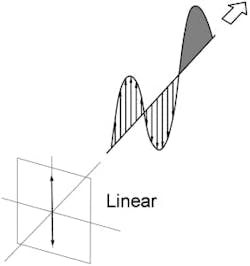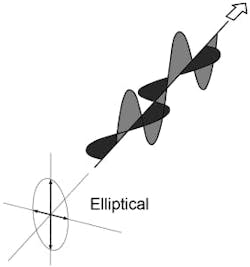What is Optical Polarization?
- Optical polarization, a crucial aspect of optics, involves intricate interactions between light and matter.
- While optical design typically focuses on wavelength and intensity, polarization’s subtle influence is widespread, impacting applications from stress analysis to LCD screens.
- Polarization’s omnipresence stems from its ability to modulate light-matter interactions. Linear, circular, and elliptical polarizations offer diverse control options, utilized in photography, chiral molecule analysis, and biomedical imaging.
- Precise polarization control is vital for suppressing reflections, enabling innovations in telecommunications and sensors. As optics advances, nuanced polarization control promises ongoing innovation and discovery, shaping the future of optical science.
The world of optics is a realm of intricate interplays between light and matter, where understanding and manipulating the polarization of light stand as essential pillars. While optical design often fixates on the wavelength and intensity of light, polarization, an intrinsic property of light, subtly influences even those optical systems that do not overtly measure it. The implications of optical polarization are vast and extend across various applications, from laser beam focusing and filter cut-off wavelengths to the prevention of unwanted back reflections. Polarization proves indispensable in diverse fields, including stress analysis of materials, pharmaceutical ingredient examination, biological microscopy, and the underpinnings of LCD screens, 3D cinema, and anti-glare sunglasses.
Optical polarization transcends the electromagnetic spectrum’s boundaries, exerting its influence across all regions. This omnipresence arises from the polarization state’s ability to modulate light’s interactions with diverse forms of matter. In spectroscopy, this property opens doors to explore distinct light-matter interactions within targeted molecules. Adjusting incident light’s polarization also offers a lever to initiate various photoinduced processes in a sample.
Moreover, the precise control of polarization finds merit in numerous optical applications. Such control becomes crucial in thwarting unwanted back reflections from optical components and unlocking opportunities in telecommunications and data transmission through optical fibers. Changes in a material’s polarization response under specific environmental conditions, such as stress and strain, serve as the foundation for creating sensors. However, mastering the art of optics demands the development of technologies capable of maintaining and manipulating light’s polarization states with precision.
In the realm of polarization, three fundamental types emerge: linear, circular, and elliptical. Linear polarization confines the oscillation of the electric field to a single plane, aligning either vertically or horizontally. In the context of optical applications, understanding the relative orientation of the oscillating electric field concerning the plane of light incidence becomes pivotal. This distinction gives rise to the designations of “s” polarization (electric field perpendicular to the plane of incidence) and “p” polarization (electric field parallel to the plane of incidence). Linear polarizers find widespread use in photography to mitigate glare, especially when dealing with unpolarized scattered light. This proves particularly advantageous in machine vision applications, where automated algorithms rely on pristine, high-quality images. Some applications even harness polarization information alongside wavelength and intensity data, demonstrating the multifaceted role of polarization. By manipulating the relative orientations of multiple polarizers, the intensity of light can be modulated, enabling the absorption or transmission of varying amounts of light.
Circular and Elliptical Polarization
Circularly polarized light introduces a twist to polarization. It comprises two perpendicular electric field vectors with a fixed phase difference of π/2, creating a dynamic evolution of polarization direction over time. Analogous to linear polarization’s vertical and horizontal orientations, circular polarization categorizes as left-handed or right-handed, depending on the electric field vector’s alignment relative to the propagation direction.
Elliptically polarized light, a cousin of circular polarization, retains the π/2 phase difference but exhibits differing magnitudes between the two electric field components. This peculiarity imparts an elliptical shape to the trace of the electric field vectors as they propagate, distinguishing it from the perfect circle of circular polarization. Elliptical polarization encompasses a broader spectrum of possibilities, with circular and linear polarization serving as special cases within this diverse polarization landscape.
Applications of Polarized Light
The multifaceted nature of polarization unlocks a treasure trove of applications across scientific and technological domains. Circularly polarized light assumes a prominent role in probing chiral molecules, which are mirror-image twins that resist superimposition, akin to our hands. While many chiral molecules possess identical linear absorption spectra, the use of circularly polarized light unveils their differences, enabling the recording of circular dichroism spectra.
Elliptical polarization and other exotic polarization schemes find their niche in suppressing scattering and facilitating depth-resolved imaging in various contexts. Biomedical imaging, in particular, benefits from polarization control as it allows intentional probing of specific layer depths, mitigating unwanted signals from neighboring tissues. The ever-advancing field of optics continues to expand polarization control possibilities to previously uncharted territories, including the extreme ultraviolet spectrum, promising novel optical methodologies.
In conclusion, optical polarization stands as a remarkable facet of light, casting its influence far and wide in the world of optics. Its diverse applications, from unraveling the secrets of chiral molecules to enhancing imaging and enabling advanced technologies, highlight the indispensable role played by polarization in shaping our optical landscape. As optical science continues to advance, the nuanced control of polarization promises to usher in a new era of innovation and discovery.



